Lexus GS450h F Sport


- The arrival of our Lexus hybrid
- Lexus interior - the good and the bad
- Real world economy in the GS450h
- The much-maligned Lexus mouse controller
- The GS gets ready for winter
- The CVT gearbox - a love hate relationship
- Small niggles with the GS450h
- Our Lexus heads off to Spain
- More big miles in the GS450h
- Hybrid delivers rapid performance
- Lexus vs hybrid rivals
- Lexus GS450h - the final reckoning
The arrival of our Lexus hybrid
The newest addition to our cars is the Lexus GS450h - the first hybrid we've had on the fleet. So how will it fare over the next six months?

Date: 27 September 2013 | Current mileage: 804 | Claimed economy: 45.6mpg | Actual economy: 36.2mpg
Despite being 'only' 35, I'm a big fan of a the traditional large saloon. Maybe it comes from growing up in a family where we always had a saloon – a Mercedes to be precise – or perhaps it's the fact that even though there are more niches and categories than ever in the car market, the saloon – although not the most practical or most sporty of models – soldiers on.
In the past I've run an Audi A6 for Our Cars followed by a Jaguar XF. Two cars I really rated. So I'm looking forward to our latest arrival, the Lexus GS450h. It will not only be the first hybrid we've run on honestjohn.co.uk but also the first Lexus. The luxury brand from Toyota is trying to give its image a shot in the arm with the likes of the new GS range and the IS, with aggressive styling, more modern interiors and more enjoyable handling.
The styling certainly stands out. The GS450h used to be a fairly bland looking car and while this new model hasn't gone for any big creases down the sides and across the doors, the designers have given it a striking front end. Our model is an F Sport so gets bespoke bumpers which give it more presence than the standard Luxury and Premier versions. The front end has already drawn comparisons with Darth Vader's mask. Personally I really like the styling and I've noticed it drawing a fair bit of attention when it's parked up.
The F Sport also gets 19-inch dark grey alloy wheels which I think look great. Although I am a sucker for a set of dark alloy wheels as the Audi A6 I ran shows. They do give it a bit more menace though and work really well with the black paintwork. I was torn between black and dark grey paint for the GS, although to be honest the colour choice isn't exactly huge. There's a rather old-man dark red, white which seems far too common these days and silver. The latter does look good with the dark wheels but I can't bring myself to have a silver car. So in the end I went for boring old black. And I'm really pleased with how it looks.
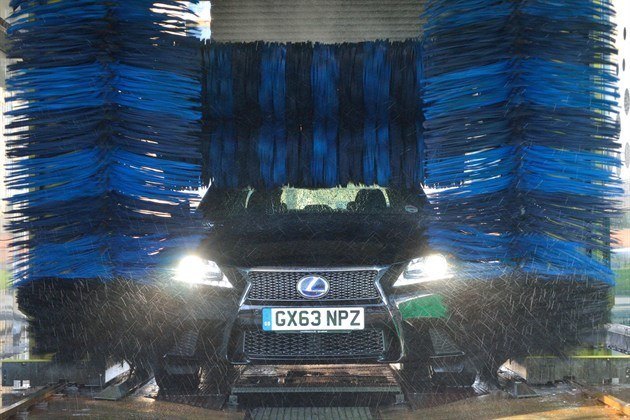
The Lexus in a car wash. This is likely to become a familiar sight.
Of course after two weeks with the GS450h I've already realised why having a black car is a pain. It gets so dirty so quickly. And as I live off the end of an unadopted (and consequently unsurfaced) road, the Lexus is constantly covered in dust and dirt. I think I'll soon be on the Christmas card list of the local car wash.
In terms of standard equipment the GS450h F Sport is pretty much fully kitted out. Not surprising given this is the top of the range model. In fact so comprehensive is the standard equipment list that we've not had to add any options. At all. A rarity on pretty much any car these days. That said it's not exactly cheap at £51,000 but I'll be looking at how it compares to the competition in a future update.
It comes with everything you'd expect like leather sports seats – heated and ventilated naturally – while pretty much anything that could be electric is. There's even a rear window sun shade. I'm currently getting to grips with the multimedia system and it's strange mouse control but more of that in a coming update. First impressions are that it's actually easy to use if not the best looking of systems on screen.
So far I've covered 800 miles in the GS450h and it's starting to grow on me. The hybrid system is very smooth and quiet yet still powerful. In fact it's a bit like a rocket when you want it to be. That's borne out by its 0-62mph time of just 5.9 seconds helped by the CVT gearbox. But for now it seems to be spending a lot of its time in traffic which means a chance to let the electric motor do much of the work. Over the next two weeks I'll be covering some long motorway journeys so we'll see how the Lexus is in what should be its natural environment.
Lexus interior - the good and the bad
The interior of the latest GS450h is far more modern than the old model yet there are still some old fashioned touches.

Date: 11 October 2013 | Current mileage: 1217 miles | Claimed economy: 45.6mpg | Actual economy: 36.4mpg
So we're a month into our time with the big Lexus and the first 1200 miles have given me a chance to appreciate the refinement of the GS. Obviously it's very quiet thanks to the hybrid system which means zero noise when you pull away and then a feint bit of sound when the engine kicks in. After driving big 3.0-litre diesels in the A6 and XF I've surprised myself in how quickly I've adapted to the slightly different way a hybrid drives.
Hybrids are nothing new of course and Toyota was a real pioneer of the technology, the first Prius was launched in 1997. And in Lexus models like the GS and RX, you get the best of both the performance and economy of a hybrid. I clearly remember the first time I drove the original GS450h and how amazingly quick it was away from a standstill thanks to electric motor's instant torque.
What was always strange about the original GS450h was how, for a car with such modern technology, it had such an old fashioned interior. It seemed to come from a time when Japanese manufacturers were getting their inspiration for premium car interior from old Jags. There was a lot of wood and a lot of buttons.
Thankfully the cabin of the new GS is better. Much better. There was never a question mark over the build quality of the old car, but now the GS has a stylish and premium cabin that echoes its price tag. With the likes of Audi and BMW as rivals, it's essential Lexus gets this element spot on. Simply building a reliable and well engineered car is not enough.
Compare old and new is like chalk and cheese. All that awful wood has gone, replaced by some high quality metal detailing. The clock in the middle of the air vents is a lovely feature as are the proper metal dials for the stereo controls which have a rewardingly solid action. It does have the feel of a high end stereo. And best of all it feels like more than just a posh Toyota. But what surprises me is that alongside some very modern touches, the Lexus still has some old fashioned hangovers.
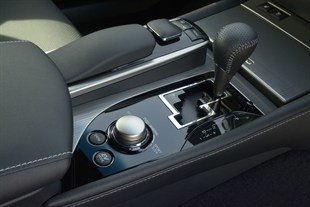
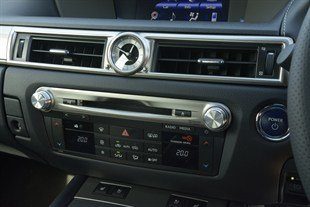
Old school gear lever stands out in the modern Lexus as does the dated climate control display
The air conditioning controls are a prime example. The digital display looks like it's from a 1980s microwave and the square buttons aren't much better. It is easy to use – I’ll give it that – but it doesn't exactly scream cutting edge. However, the new IS has some really funky air con controls so maybe they'll make their way onto a facelifted GS in the future.
Elsewhere the analogue dials now seem a bit old hat compared to what the likes of Audi and BMW are doing. I personally do like their honest simplicity but they just don't seem in keeping with a car that's supposed to be all about innovation. Even my old 1985 Vauxhall Senator has a digital dash. But what really stands out for me is the old-school gear lever. Forget Jaguar with it's dial selector that rises from the centre console or Audi with its yacht-inspired lever, Lexus is sticking with the trusty traditional automatic gate layout. Again, given the Lexus brand is all about technology, it just seems very dated.
On the plus side the GS no longer has a foot operated parking brake. Thank god. Something which fellow Japanese brand Infiniti is still putting in its new cars. Instead the GS gets an electric parking brake with auto hold. The button is hidden away somewhat, down by your left knee, but seeing as it comes on automatically when you need it, I haven't actually had to apply it myself yet. It's probably the best electric system I've come across in that respect. Usually they just annoy me.
What does stand out in the GS cabin is the very unusual mouse controller right next to the gearlever. Lexus has shunned the combination of touchscreen control and a dial control that most of the competition use. Instead you have to move a mouse about which does take some getting used to. But more of that in a future update. Right now I've got to get the Lexus washed again and investigate why it won't lock itself when you drive away.

The old Lexus GS450h. Wood central.
Real world economy in the GS450h
Is hybrid power the future? We're not yet convinced but real world economy in the Lexus is actually pretty impressive.
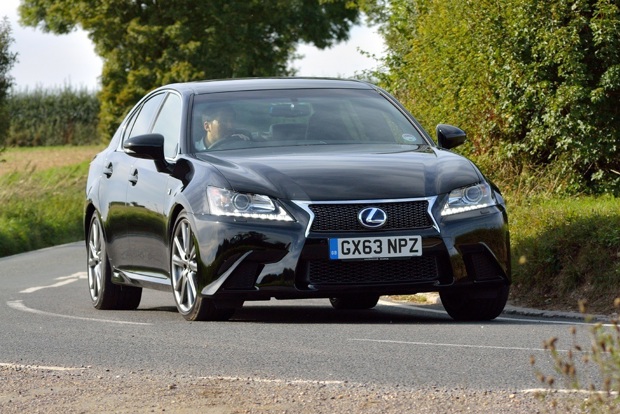
Date: 25 October 2013 | Current mileage: 1866 | Claimed economy: 45.6mpg | Actual economy: 37.1mpg
I've always been a big fan of big saloons with big diesel engines. For me something like a BMW 530d is the ideal car - comfortable, quick thanks to its six-cylinder engine yet still reasonably cheap to run with economy of more than 50mpg. I've yet to be won over by hybrid power as a realistic alternative, but the Lexus has six months to convince me otherwise.
So far it's doing a good job. The more I drive it, the more I like it and while it does have its weaknesses - the on/off brakes are still an annoyance - its strengths are really impressing me. For one, the performance is astonishing, it's a car that feel as quick as anything I've driven of this size, with great acceleration from 40mph upwards. Overtaking is so straightforward as is joining fast flowing traffic on a dual carriageway from a tight slip road. It really gives you huge confidence thanks to that instant power delivery.
So, over the past few weeks, the Lexus has been doing the usual motorway journeys with several early morning trips to Heathrow for flights and the usual stop start traffic on the M25 as well as several trips across to Stansted. From Bedfordshire it's not a straightforward drive - getting east to west in the UK rarely is - and involves a bit of a long winded cross country route. The alternative is down the M1, round the M25 and back up the M11.
Through all these miles I've had one eye on the economy as I look to improve the numbers. According to the official figures the GS450h can average 45.6mpg and until now it's been hovering around the 36mpg mark which I think is pretty acceptable, especially as I've been driving the Lexus quite hard as I continue to see what it's capable of. However I do think it should be better.

An avalanche of dull plastic and pipes it may be, but this is where the hybrid magic happens
According to Real MPG other GS450h owners are seeing an average of 38.2mpg and I think with more gentle driving our car should easily achieve that. In fact over the past two weeks it has already risen to 37.1mpg and that's without too much of a change in my driving style. If you don't know what Real MPG is by the way (where have you been...) it's our own way of providing real world fuel economy figures as an alternative to the official manufacturers' figures.
These are rarely achievable - you can find out why here - so we hope our figures will be a more realistic. You can submit your own fuel economy to help create what we hope will be a huge database of real economy figures. We've already had more than 45,000 submissions and it continues to grow. Where it comes in so useful is the ability to compare different models - ideal if you're buying a new car.
Of course the GS450h isn't just about fuel economy. Although if you view it as a saloon with similar power to a 4.5-litre petrol engine - which is why it's badged 450h even though it actually has a 3.5-litre engine - then fuel economy of 37mpg is mightily good. What really appeals to company car drivers - and to those with an eye on running costs - is the low CO2. It emits 141g/km - which incidentally is pretty much identical to a BMW 530d at 144g/km. This means it's a band F car with annual VED of £140 which is actually less than the Honda CR-V 2.2 i-DTEC I had previously.
Meanwhile, with winter fast approaching, I'm going to investigate the potential of fitting the GS450h with winter tyres as otherwise the hybrid could be going nowhere not very quickly when the inevitable snow and ice comes. I fitted them to the A6 we ran last winter and they proved invaluable so I think it will be shrewd to do the same for the Lexus this year.
The much-maligned Lexus mouse controller
Rather than a dial or touchscreen, the GS is fitted with a mouse-like controller for accessing all the on board functions. But it's not proved popular...
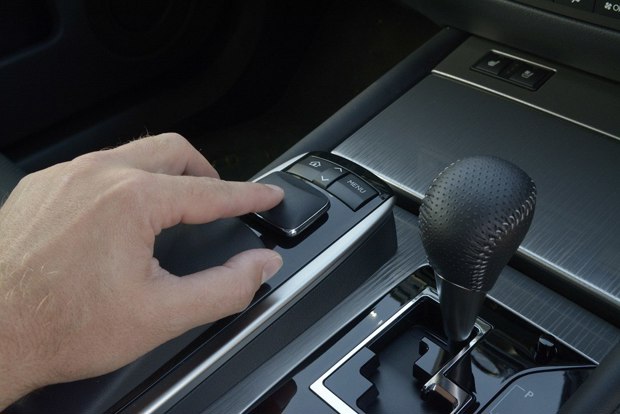
Date: 8 November 2013 | Current mileage: 2120 | Claimed economy: 45.6mpg | Actual economy: 36.7mpg
So I've now spent almost two months with the GS450h and I have to say, the more I drive it, the more I like it. It's such an effortless and smooth car with impeccable refinement. On long journeys it's really in its element. The seats are supportive and comfortable, it seems to glide along on the motorway and yet there's still some mighty performance when you want it.
The more time I've spent behind the wheel, the more time I've had to play with all the various settings and systems. Which brings me onto the Lexus 'mouse'. Because rather than go with a dial controller such as the BMW iDrive system, or a touchscreen like Jaguar and Land Rover, Lexus has gone down a different route.
It calls it the Remote Touch Interface multi-control device. Very fancy. Lexus first used it on the RX450h and since then it has been improved, making it - according to Lexus at least - easier and more intuitive to use. It’s the first system of its kind to adopt a slide haptic joystick mechanism – a slide-type controller that’s much like a computer mouse.
So in order to navigate the main screen you simply move the mouse around. The haptic feedback is very useful as it sort of pulls the mouse toward the main functions on the screen, so you're not simply moving a cursor around aimlessly. It is very strange though and unlike any other system on the market. Of course as with any system you get used to it but I do still find it overcomplicated to use at times.

Lexus main screen display doesn't look especially modern
The problem is that when you're on the move, trying to drive and move the mouse around isn't that easy. Admittedly using touchscreen systems can be equally tricky, especially if you've got a car with a firm ride or you're on a poor quality road. Trying to touch a particularly button on the screen can prove frustrating as I used to find on the Honda CR-V. I prefer a dial system and personally I find the Audi MMI system the easiest to use.
That said, the GS450h does have a huge display screen. At 12.3 inches it's among the largest found in any production car and it's recessed well in the dash top making it easy to see even in bright sunlight. I like the way it's designed as part of the dash design too rather than sitting on top like some do.
The system itself is pretty decent although it doesn't look the best. The menu design seems a bit old fashioned and doesn't reflect the modern technology in the rest of the GS450h. It's like using a 10 year old mobile phone at times. There are plenty of plus points though. The navigation is excellent with quick routing and has live traffic information (which will offer you an alternative route) plus it takes seven digit UK postcodes.
The audio part of it is very good too. Especially when you connect an iPod. Searching through artists is easy as rather than having to scroll all the way through from A , it allows you to jump to different artists by letter, grouping them A to D and E to H and so on. Few other systems are as straightforward to use.
The GS gets ready for winter
Just in time for the cold weather, we get our GS prepared for winter with a fresh set of winter tyres which will hopefully keep us mobile if it snows.
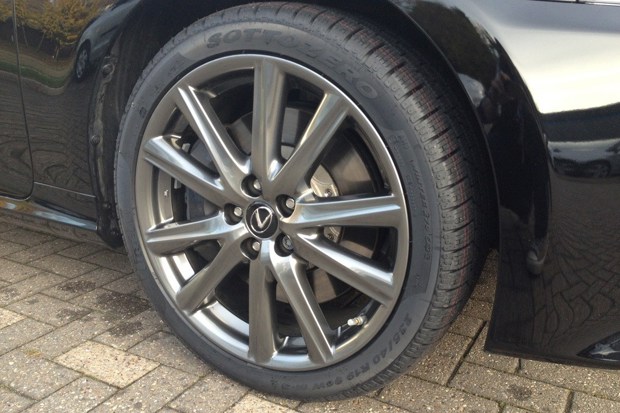
Date: 26 November 2013 | Current mileage: 2444 | Claimed economy: 45.6mpg | Actual economy: 36.9mpg
With temperatures dropping this week I've timed it well to get winter tyres fitted to the Lexus. I'd actually planned it a few weeks ago but as often seems to be the way, there was a delay in getting hold of the right tyres for our Lexus. But luckily there's been no snow or ice so far and the Lexus has been fine on its standard summer Bridgestone Potenza RE050A tyres.
However, I'm very pleased to have now got the winter tyres sorted. Especially with snow predicted next week and a several trips up north planned. I'm also pleased that I haven't had to have different wheels fitted to the Lexus. Unlike two years ago when I had to swap the 20-inch wheels on the Audi A6 I was running for some very plain 17-inch alloys.
That said, I do think the Lexus would look quite good with a set of black steel wheels on. It also means that if you do end up sliding into something like a kerb, the damage won't be as costly as it would to an alloy wheel. However, this year I've been able to keep the same wheels on and just changed the tyres. So now the GS450h is running on Pirelli Sottozero Serie II tyres with 235/40 R19 on the front and 265/35 R19 on the back.
These have an asymmetric tread pattern with the inner part designed to expel water and the outer area, with its more rigid and spaced blocks, designed to give high levels of grip in snow. So now I'm actually hoping we have snow so I can test them out. The GS450h also has a snow setting for the gearbox so it could turn out to be pretty good when the cold weather really sets in.
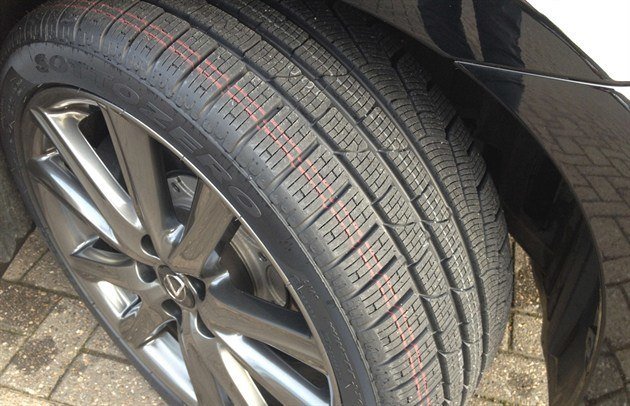
New Pirelli Sottozero winter tyres mean the GS450h should be onto a winner when it snows
Of course winter wheels and tyres are a common look on the continent where in many countries winter tyres are compulsory. Considering the difference they make to safety it makes a lot of sense and seeing the chaos that even a few centimetres of snow causes us here in the UK, I think we should have a similar law. True there's the expense of another set of tyres, but while you have winter tyres on, your summers aren't being worn. So you're just spreading the miles covered over two sets of tyres.
What I have noticed is how much quieter the Pirelli winters are compared to the Bridgestones and although they aren't quite as grippy in high speed corners, they're still mightily impressive for a winter tyre. The ride is ever so slightly better too. So overall I'm very pleased so far. Although I'll have to wait for snow and ice before I give a final verdict.
It's not just the snow though. Below 7C winter tyres are more effective. With normal summer tyres the rubber loses its flexibility in the cold. It’s all to do with the compound of the tyre. Cold weather tyres have a higher ratio of natural rubber and silica in the compound which doesn't stiffen up as much as synthetic rubber in cold conditions. Therefore the tyre is more flexible and able to perform like a tyre should. Summer tyres simply go hard in the cold temperatures.
Aside from the tyres, I've topped up the washer fluid in the Lexus. I've now invested in a funnel so I don't leak it all over the engine bay. Seeing as the car is only two months it only needed a small amount. Aside from that everything else appears to be as it should, not that you can really tell given how the GS engine bay is basically a large bit of plastic. So winter here we come!
The CVT gearbox - a love hate relationship
Although I appreciate the advantages of CVT gearboxes I've never been a fan. And with the GS I've developed a love hate relationship.

Date: 10 December 2013 | Current mileage: 2612 | Claimed economy: 45.6mpg | Actual economy: 36.2mpg
Hybrids have traditionally come with a CVT gearbox - the old 'rubber band' transmissions that most people associate with the DAF 55. They may sound old fashioned but they make a lot of sense. Continuously variable transmissions are good for fuel economy as they allow the engine to run at the most efficient revs, an ideal gearbox choice for a hybrid then.
Toyota and Lexus hybrids have always used CVT gearboxes and the GS450h is no exception. Obviously it's a bit more sophisticated than the old DAF 55 version but the theory is still the same. I have to admit that despite the advantages a CVT offers I've never been a big fan of them, whether in hybrids or conventional diesel and petrol engines.
It's not the performance, if anything CVT gearboxes delivery surprisingly good acceleration compared to a conventional automatic, especially as there are no separate gears and so no loss of power as the gearbox shifts through the gears. Indeed in the GS450h the CVT means constant acceleration and a 0-62mph time of 5.9 seconds. Even more impressive is the acceleration from around 40mph which is all important when joining fast flowing traffic from a short slip road.
It's a strange sensation though. While you may be accelerating quickly, it doesn't feel like it from behind the wheel. The lack of gearchanges is somewhat counterintuitive when you've been used to standard gearboxes and you tend to feel detached from what's going on. It's not a car that pins you back in your seat.
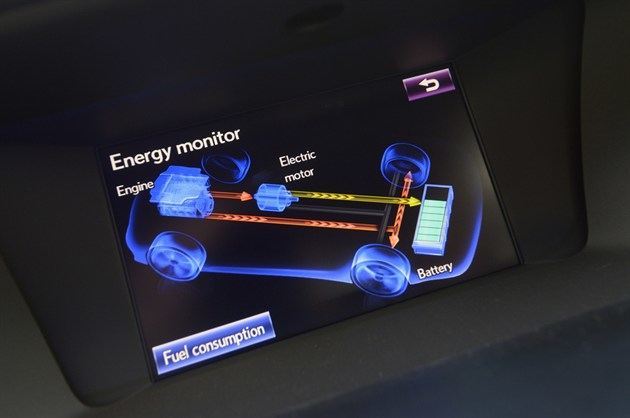
Energy Monitor screen shows you where the power is flowing
And then there's the noise. The whine that accompanies acceleration is not pleasant and makes the car sound like it's working too hard. Even in the powerful GS450h it's not that pleasant a sound, while in smaller hybrids like the Prius, it's a bit like a washing machine getting to full spin. There's none of the grunt you get from a diesel as the engine power peaks high up the rev range at 6000rpm.
What the CVT does do is encourage you not to accelerate too hard. It's a lot more pleasant a driving experience if you're gentle with your right foot. Plant it to the floor and all you do is create that awful whine while economy drops too. Treat it with a bit more finesse and it's a far more relaxing car to drive - and a more economical one too.
So over the past few months I've come to appreciate the CVT gearbox a lot more. I wouldn't say I'm a convert and choosing a hybrid doesn't have to mean having a CVT - the likes of the Infiniti M35h (or Q70 as it's now known) and the BMW ActiveHybrid5 both use conventional automatic gearboes. But the Lexus remains incredibly refined and relaxed - and much of that is down to the CVT.
And talking of rival hybrids, i'll soon be testing the GS450h alongside the Infiniti Q70. Until then the Lexus will be taking me to Spain for the new year giving me a chance to really put some miles on and see how it copes with covering several thousand miles in a few days.
Small niggles with the GS450h
After three months and several thousand miles I'm starting to notice a few small issues with the GS450h.
Date: 23 December 2013 | Current mileage: 2989 | Claimed economy: 45.6mpg | Actual economy: 36.0mpg
After three months and almost three thousand miles, the Lexus is getting a short Christmas break - as am I. The GS450h has been pretty much faultless during its time with us so far and as it sits outside in the pouring rain looking filthy, unlike the nice picture below, it's about time for a half-time review of the good and bad.
I still think it's a great looking car. Seeing the pictures from when it first arrived remind me of what a sharp and clean design it is. When you get into a car everyday it's sometimes easy to not actually appreciate the design, especially as my view is over the steering wheel. But as our pictures show, it's a strong design and I particularly like the rear with those mean-looking rear light clusters.
Of course I've rather ruined those neat lines with my M25-ring sticker - a hangover from our M25 challenge of a few years ago in the Polo BlueMotion. However I seem to be spending a lot of time on everyone's favourite road to nowhere so that's my excuse for carrying it over. And it was on a recent trek around the M25 that the stereo system in the Lexus decided to freeze up. One moment it was fine - playing my iPod - and then suddenly nothing. No radio either.
The sat nav still worked as did the rest of the system, but there was no sound from anything and it wouldn't detect my iPod. The only way to fix it was to stop, turn the car off and then restart it. Annoyingly this meant having to come off a slip road so I could come to a stop. Since then the system will often freeze my iPod at random points. This requires having to reboot my iPod and then reconnect it. It happens about once a week on average and is becoming quite annoying.
![]()
The GS450h may have a few issues but it's a still a great looking car
Other small niggles include the lack of a digital speedo in the trip computer screen. These are commonplace on modern cars and not just at this size and price either. Indeed many Citroen models only have a digital speedo as did the old Honda Civic. I find it useful to have a digital display alongside the traditional analogue dial - it was a feature on the Audi A6 I ran and the Jaguar XF so it's surprising that the Lexus - a car filled with technology - doesn't have it.
I've also yet to work out how to turn on auto-locking. Most cars will automatically lock when you drive away but not the GS450h. It's a useful security feature - I know of several stories where people have had bags stolen from the back seat while they've been sat in traffic with the doors unlocked. In the handbook it states you can do it from one of the menus in the on board system, but that doesn't correlate with our car. It's something I will have to phone a dealer about but seems frustrating when it should be straightforward.
These may sound like small issues but they're the kind of things you notice after a few months with a car. In a few days I'll be driving to Spain in the Lexus which will give me a chance to see if any more niggles become evident. The rather short boot is already proving an issue - because of the batteries Lexus has sacrificed some boot space with 465 litres compared to 547 litres in a standard petrol GS250.
It's not small by any means, but the lack of depth is noticeable compared to something like a BMW 5 Series and means that with a suitcase and a few boxes in, there's not much room left. The odd hinges of the boot that intrude don't help either and so I've had to load other odds and ends into the back of the car.
Our Lexus heads off to Spain
A trip to Spain for the new year saw me covering more than 2500 miles in the GS450h but economy still isn't great.
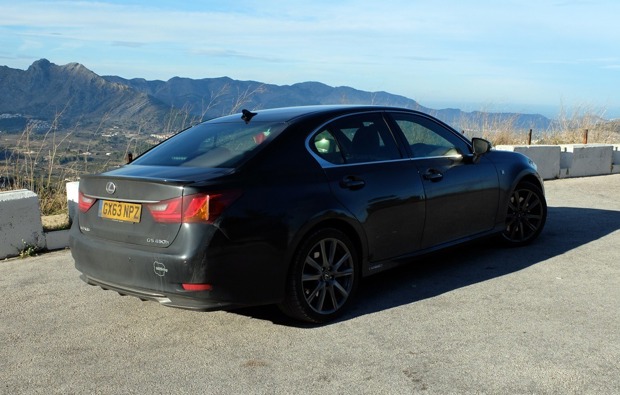
Date: 6 January 2014 | Current mileage: 4421 | Claimed economy: 45.6mpg | Actual economy: 35.6mpg
New Year saw me heading off to Spain to visit friends, but rather than go for the easy option and fly down, I decided to drive, giving me a chance to test the Lexus on a proper long run. It may seem a slightly crazy option - indeed everyone I told thought it was madness not to just jump on an EasyJet flight, but I'm one of those odd people that would happily spend hours behind the wheel through France and Spain rather than face the chaos that is Stansted airport around Christmas.
So with my Eurotunnel Crossing booked, I headed off early doors on the Sunday between Christmas and New Year's Eve. My final destination was Moraira on the Costa Blanca, about an hour up the coast from Alicante. The weather wasn't too bad - wet and grim with an average of about 7C - but with my winter tyres fitted I was prepared for any worsening conditions on the continent.
It was fairly busy at the Eurotunnel terminal. I can never seem to predict whether it will be busy or quiet but it seemed a lot of Brits were heading abroad after Christmas. Thankfully it was all running on time so 35 minutes later I was in France heading down toward Bordeaux. There are various routes through France to Spain and over the years I've tried nearly all of them.
What I always try and do is avoid Paris. Because you never can tell what the traffic will be like on the peripherique, even at quiet times. It also feels to me like it's slowing me down so I prefer to go round, either heading west toward Reims and down the E11 past Clermont-Ferrand (a road that seems to go on forever) or east through Rouen (and it's awful roadworks) and down through Tours. It's the latter I went for this time with a hotel room booked at a Campanille in Bayonne, not far from the Spanish border.
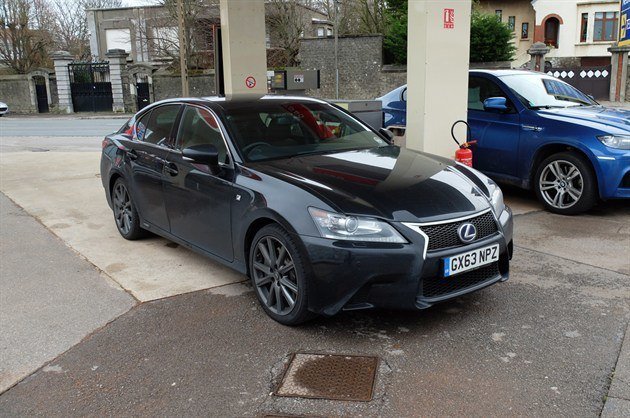
The GS450h at a fuel station - an all too familiar sight on our trip to Spain
What's great about French autoroutes is how quiet and relaxing they are to drive on. There's less of the aggression you tend to get on UK motorways and less traffic. Of course the fact they are toll roads helps and heading through France on a Sunday - when French-registered HGVs aren't allowed to work - meant it was even quieter. It's lovely to be able to set the cruise control at 130km/h and be able to realistically work out how long it's going to take you to cover a set distance.
Of course the average speed does come down when you have to stop for tolls or fuel. And here is a weakness of the GS450h. Even at gentle cruising it was only achieving an average of 35mpg between fill-ups. Admittedly the boot was pretty packed up but there were no passengers in the car. The average claimed figure is 45.6mpg but the best I ever saw was 37mpg. That's not terrible for a car with this much power but with a 66-litre fuel tank it seems I was constantly filling up. Strangely, even with the range at zero miles, I've only ever managed to put a maximum of 57 litres of unleaded in - and that's brimmed to the top.
Still what shone through as I headed through France was the amazing refinement of the Lexus. It's wonderfully quiet and smooth - almost limousine-like - at speed, helped by the Pirelli winter tyres which are quieter and more comfortable than the Bridgestone summer tyres fitted before. The superb seats are another highlight with good support and so much adjustment. The electric lumbar support is especially good and even after 14 hours behind the wheel, I didn't have a sore back.
There are some small things that could be better in my opinion. I've already spoken about the lack of a digital speedo - it would have been useful to have one that could then be switched to kmh - and the trip computer could be better too. The display is fairly old fashioned and it doesn't give you as much information as others. There's no timer to show you how long the journey has taken you - useful if you want to quickly see how long you've driven for. In total, to get to Moraira, the Lexus covered 1400 miles. In the next update I'll be reporting on the return journey.
More big miles in the GS450h
The return leg from Spain gave me a chance to appreciate the refinement and quiet nature of the Lexus.
Date: 20 January 2014 | Current mileage: 5743 | Claimed economy: 45.6mpg | Actual economy: 35.8mpg
After my long and direct drive down to Spain which I reported in my previous update, the return leg was a lot more leisurely as I gave myself several days to drve back to the UK with a few places to visit on the way back. So the day after New Year's Day we set off from Moraira with a fully loaded car, to drive across Spain to San Sebastian - going from one coast of Spain to the other heading from the Mediterranean to the Bay of Biscay.
Driving through Spain is always relatively quiet but especially so around the new year. We headed up the coast from Moraira to Valencia and then on the A23 toward Zaragoza. It was one of the quietest stretches of road I've ever driven on, barely passing any other vehicles. Once again it's a case of leaving the cruise on 130km/h and just steadily making progress. It's tempting to go quicker but given the long distances we were covering and the fact we weren't in a rush there seemed little point in taking the risk.
The Lexus once again proved super smooth on the motorway and was a real pleasure, especially when I got to have a break from driving and relax in the passenger seat. Unfortunately the infotainment and iPod problem returned and was getting more frequent - it happened about six times during the drive and was becoming a real annoyance, especially as fixing it required pulling off the motorway to turn the car off and then back on again.
So in the first day we had a good run and ended up in San Sebastian. The picturesque town is where tapas originated and it's a lovely place to spend a few days. Unfortunately we only had one afternoon and evening there but it was still good to get out of the car and have a wander around, even if it was pretty cold. The next morning we were back in the Lexus and heading into France.
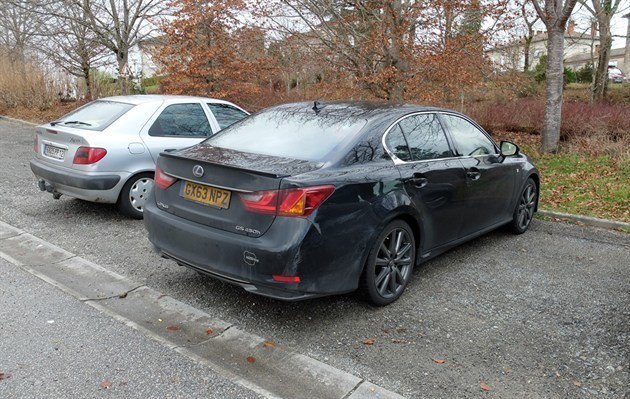
The very dirty Lexus gets a rest as we head through France
Heading from Spain to France there seem to be a host of tolls on the Spanish side. Some which are barely a few miles apart it seems. And many which are just a few euros (one was €1.12 ridiculously). It was when accelerating away from one of these toll booths that the Lexus suddenly developed a vibration from the wheels that was really noticeable through the steering column.
A quick stop and visual check didn't identify anything untoward - all the wheel weights were present and there was no sign of a nail or anything similar in any of the tyres. It carried on over the next few miles but then as quickly as it appeared it disappeared again. Very strange. Through France I also noticed that the GS has developed a slight vibration under braking, very reminiscent of the issue I had with the Jaguar XF. It's not as bad just yet but I'm monitoring it.
So through France we headed to a village called Oradour-sur-Glane. I'm very interested in history, especially military history and it's a place I've always wanted to visit. It's now kept as a permanent memorial to a war-time atrocity that took place in June 1944. It's a moving and memorable place to visit so I was pleased to have finally got the chance to see it.
That evening we headed to Tours for our final night in France. Given time we could have carried on to Le Mans but given that it's not the nicest town in France, despite its association with the famous 24 hour endurance race, we thought it more prudent to stay in Tours which is a far more pleasant place. Still the journey from Oradour was eventful as the Lexus fuel level got very low with no petrol station in sight. The joys of rural France. Luckily one came on the horizon as the range got to zero miles. It was certainly a rural fuel station with just two pumps and a lady who came out to fill it up.
The final morning was the drab slog back through Rouen and up to Calais. The rain and grim grey of Northern France is rarely inspiring and this was no exception. Still after the EuroTunnel crossing, which was very busy, the UK was no better with even more rain and lower temperatures. Welcome back to Blighty! Overall we covered more than 2500 miles and averaged 35.8mpg all told. That's better than I've seen but still short of the official 45.6mpg.
Hybrid delivers rapid performance
While a hybrid system is designed to delivery low emissions the GS450h isn't shy when it comes to performance.

Date: 10 February 2014 | Current mileage: 6112 | Claimed economy: 45.6mpg | Actual economy: 35.6mpg
While hybrid cars are designed to lower emissions (meaning lower annual VED and if you're a company car driver lower Benefit In Kind tax) the combination of a petrol engine and electric motor often comes at the sacrifice of performance. The fact they commonly come with a CVT gearbox doesn't help and if you're used to driving a turbocharged diesel engine, getting into something like a Toyota Auris Hybrid takes some getting used to.
Of course on paper, a hybrid has all the ingredients to delivery a performance. Alongside the standard engine you have an electric motor which delivers torque from zero revs, meaning fast acceleration from a standstill. The electric motor also works to boost engine power, for example when overtaking or going up a steep incline. The same idea is used in F1 with the KERS system which this season will work as part of an ERS (Energy Recovery System) to help deliver an extra 160bhp for around 33 seconds per lap.
The GS450h is certainly at the performance end of hybrid technology, especially compared to other models in the Toyota and Lexus range such as the Prius or the CT200h. The fact it's badged GS450h tells you something straight away. Despite actually having a 3.5-litre petrol engine, the extra electric motor delivers performance akin to a 4.5-litre engine, hence the name.
It certainly feels that quick. On paper it will accelerate from 0-62mph in just 5.9 seconds and the fact the batteries are located over the rear axle means traction is always strong, despite all the electric motor torque being on tap from zero revs. Only occasionally have I felt it breaking traction at the rear and that was in very wet conditions when trying to join a fast flowing one way system from a car park exit.
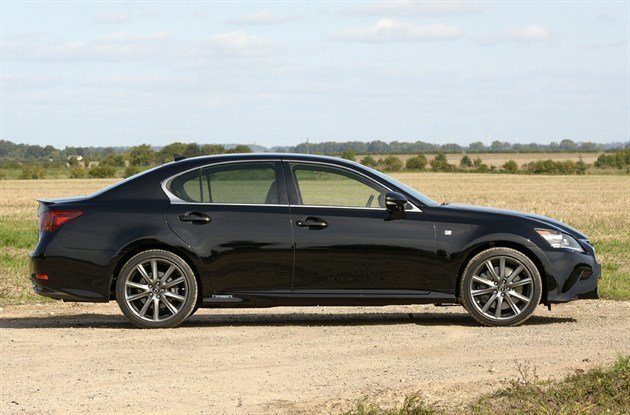
Here the CVT gearbox comes into its own. You just put it in D (or Sport) and accelerate. The Lexus just keeps going and going, gaining speed non-stop without any interruption for changing gears. The whine isn't especially pleasant and there's no sporty exhaust note, but from lower speeds it does sound quite good. It's very different from a diesel - like the Audi A6 3.0 TDI I previously ran - as there's not that split second lag as you wait for the turbo to spool up.
That said, it doesn't have the meaty torque of a diesel either, so when you ask for in-gear power, for example when overtaking from 50mph, it doesn't feel as strong as a big V6 diesel engine. Again it's not helped by the rather frantic feeling of high revs as the CVT does its thing. A diesel feels more relaxing in these situations.
The one thing that I feel lets the handling of the GS450h down is the steering. While it rides well, especially given it's an F Sport version, the steering lacks feel and is too artificial. I know that's a common complaint of modern cars and one that seems a little pointless given that all new cars will have power and electric steering systems, but some are better than others. Porsche manages it very well for instance.
The steering on the Lexus though seems very keen to self centre, so rarely can you get it effortlessly flow from corner to corner on a twisting road. You always feel like you're having to work harder than in something like a BMW 5 Series, not helped by the rather wooden brakes. That said, I still enjoy driving the Lexus, especially given its relative exclusivity on the roads. Since driving GX63 NPZ I've only seen a handful of other examples around.
Lexus vs hybrid rivals
As more manufacturers branch out into hybrid power, our Lexus GS450h has an ever increasing number of rivals.
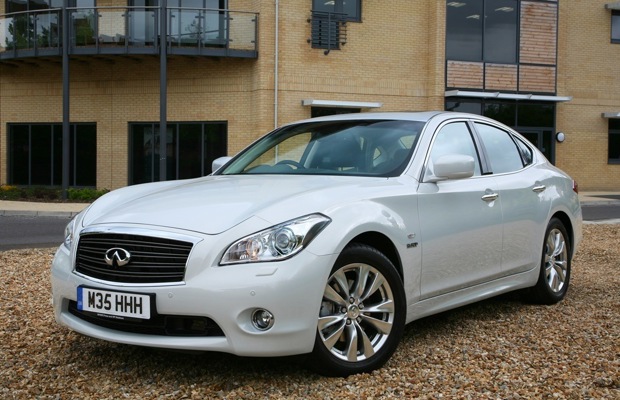
Date: 24 February 2014 | Current mileage: 7044 | Claimed economy: 45.6mpg | Actual economy: 34.8mpg
Toyota was the original pioneer of hybrid technology. The brand - along with Lexus - has always promoted hybrid power with an ever increasing range of models from the small Toyota Yaris right up the Lexus LS. But it no longer has the market to itself as we see more hybrid cars from a a wider range of brands. The fact there's now a Porsche Panamera e-Hybrid shows just how much the market is changing.
So the GS no longer has an exclusive place in the large executive market as the only hybrid. Mercedes-Benz, Audi and BMW all now offer hybrids in this class although Mercedes-Benz has taken a slightly different route with a diesel powered hybrid, the E300 BlueTec Hybrid which uses 2.1-litre diesel engine combined with an electric motor. It's a smooth system and very easy to drive. The performance isn's exactly sparkling but what really stands out is emissions of just 109g/km of CO2 - an amazingly low figure for a car this size.
The Audi A6 Hybrid uses a 2.0 TFSI petrol engine delivering 245PS while emissions are 145g/km - not a match in terms of performance to the GS 450h. The BMW ActiveHybrid5 has more power with 306PS thanks to a 3.0-litre six-cylinder petrol engine that gives it serious performance with a 0-62mph time of just 5.9 seconds - identical to the GS450h. Emissions are similar too at 149g/km.
Jaguar doesn't currently have any hybrid models, although that's more than likely to change in the next year or two as Land Rover has already debuted hybrid power in the Range Rover and Range Rover Sport. That does leave one more model - and it's quite a leftfield choice - the Infiniti Q70. We say Q70 although until recently it was called the M35h. But whatever the name - this is a four-door saloon that competes directly with the Lexus GS.
Infiniti is of course a fellow Japanese brand owned by Nissan. The manufacturer has struggled to make an impact in the UK - and indeed across Europe - despite huge investment in advertising and marketing. Most people haven't even heard of Infiniti but that's a very different story in the USA where the brand is as well known as Lexus. So what does the Q70 hybrid offer?

Well there are plenty of similarities with the Lexus GS 450h. The Infiniti is powered by a 3.5-litre V6 petrol engine that, along with the electric motor, produces 364PS in total - around 20PS more than the Lexus. On paper it outperforms the GS 450h with a 0-62mph time of 5.5 seconds, but its emissions are higher at 159g/km and the official economy figure isn't as good at 40.9mpg.
From behind the wheel the Infiniti feels as strong as those figures suggest and unlike the Lexus it has a conventional automatic gearbox. I'm not a huge fan of the CVT in the GS and the Infiniti is all the better for having a 'proper' automatic. The engine has a nice note too and there's less of the whine you get because of the CVT in the Lexus.
But the handling lets the Infiniti down. The steering is too artificial and it's not a car that's involving or enjoyable to drive. True it's very easy and relaxing, but it lacks any sparkle. Not that the Lexus is the final word when it comes to handling, but it feels more agile and responsive than the Q70. Both ride well though with minimal cabin noise on the motorway.
What surprised me about the Infiniti is the interior. It feels very ordinary and not what you'd expect of a car at this level. The top of the range Q70 hybrid costs £47,205. That's a few thousand cheaper than our GS 450h but the interior feels well below par for that money. Given that Infiniti likes to talk about how advanced much of its technology is, the interior seems very dated.
Personally I still prefer the GS 450h to the Infiniti. I think the Lexus is better looking - both inside and out - and although it's far from perfect, its performance, quality and refinement still shine through. The Infiniti feels disappointingly ordinary.
Lexus GS450h - the final reckoning
Having covered just over 8000 miles since September, David has grown very fond of the Lexus.
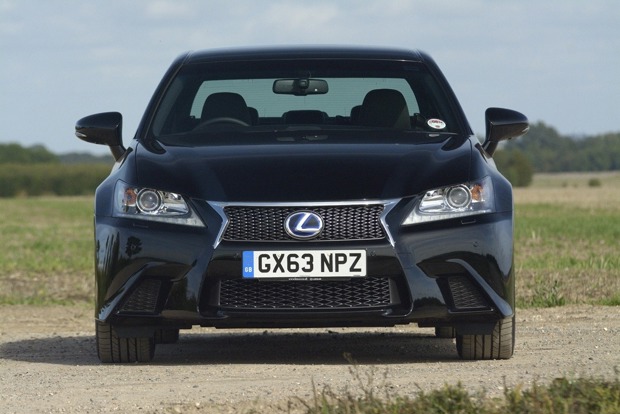
Date: 17 March 2014 | Current mileage: 8195 | Claimed economy: 45.6mpg | Actual economy: 35.0mpg
So after six enjoyable months with our Lexus GS450h it is time to hand the keys back. Having covered just over 8000 miles since September I've grown very fond of the Lexus and while the saloon isn't everyone's choice, I'm very keen to extol the virtues of the GS.
Many of my colleagues would always choose a BMW 5 Series as the their default for a large saloon. I'm no different as the BMW is a supremely good car and one I've recommended to many people. In fact my dad bought a 520d three years ago on my advice and is delighted with it. I've also previously run a Jaguar XF in Our Cars along with an Audi A6 so having the Lexus has given me a chance to compare it to the competition.
I say competition but the Lexus is a very different proposition than other executive saloons. There is of course no diesel option - only hybrid power in the shape of the GS300h and the GS450h. There was originally a petrol GS250 but this was soon phased out. Both the A6 and XF I ran previously were 3.0-litre diesels and the move to hybrid meant an immediate change in one respect - noise.
The diesel engines in the Jaguar and Audi are both refined, but even with all the sound proofing in the world they will never be as quiet and as smooth as the GS450h. There's no rumble on start-up, no vibration through the pedals, just a hushed quiet as you pull away. Getting behind the wheel of the Lexus is always a relaxing feeling - you definitely get that sense of being cossetted from the outside world.
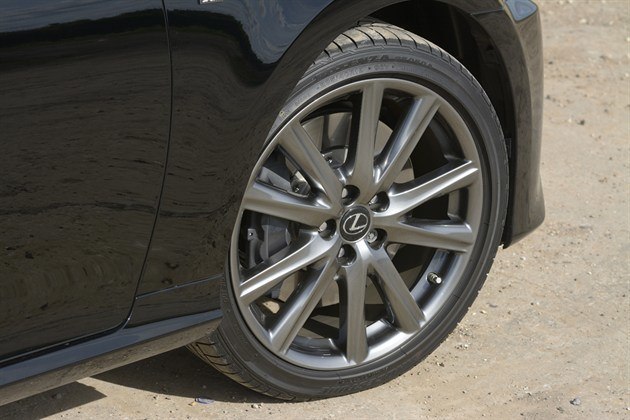
Polished dark 19-inch alloys have remained thankfully unblemished
I've had no problems with the Lexus over the past six months. Just as you'd expect from a brand that continually tops owner satisfaction surveys including the JD Power ratings. The only minor issue was the iPod interface which seemed to occassional throw a hissy fit with my iPod. There was also the strange brake shudder but that seemed to vanish as quickly as it appeared.
The effortless performance and serene nature of the GS on the motorway have really won me over. True, it's not the best handling car around with steering which is too artificial and quick to self-centre - it's not a car that flows from corner to corner while if you throw it into a bend it feels quite heavy. But I can live with that given the good ride quality, which admittedly was improved on our F Sport with the addition of winter tyres. I was able to get winter tyres to fit on the standard wheels, those lovely 19-inch polished dark alloys, which after six months remain unmarked thanks to a healthy awareness of every kerb edge I went near!
The fuel economy has probably been my biggest bugbear. I always knew it was going to be lower than I'd seen in the diesel-powered A6 and XF, but it's the way it seems to get through a tank that's a real surprise. It has often felt that I'm constantly filling it up and although it does have a smaller fuel tank than the A6 and XF - 66 litres as oppose to 73 litres in the Audi - it's still alarming how rapidly the needle on the fuel gauge seems to drop.
Then there's the whine caused by the CVT gearbox which did take me a while to get used to. I'll admit, the immense acceleration does makes up for it and i'll miss the ability to so easily overtake slower moving traffic with the confidence of all that immediate power at your right foot. Over the past six months the GS450h has really won me over and I'm sad to see it go. Whatever replaces it has big shoes to fill.
![]()
